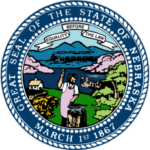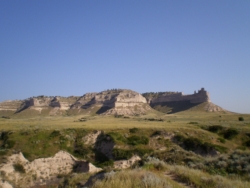Nebraska
Nebraska is a state that lies in both the Great Plains and the Midwestern United States. It is bordered by South Dakota to the north; Iowa to the east and Missouri to the southeast, across the Missouri River; Kansas to the south; Colorado to the southwest; and Wyoming to the west
- ABBREVIATION: NE
- NICKNAME: The Cornhusker State
- POPULATION: 1,868,516 (2013 est.)
- CAPITAL: Lincoln
- STATE BIRD: Western Meadowlark
- STATE FLOWER: Goldenrod
- AREA: 77,354 sq. mi.
- TIME ZONE: Most of state: Central – panhandle: Mountain
- ENTERED UNION: Mar. 1, 1867
- ALTITUDE: High, 5,424 ft. Panorama Point
- CLIMATE: Hot summers, cold winters; semi-arid in the west, more rain in the east.


Here is the crucible in which the spirit of the western settlers received a severe test. With temperatures that soar to 110 degrees on the high dry plains of the west, Nebraska can be fearfully hot in the summer months. It can also be as icily cold as 30 below in winter on the sand hills of the north central region. If it had not been for the fact that its rolling central plains were chosen for the route of the Union Pacific, Nebraska might have long remained, as an Army Engineer’s report described it in 1820, “the abode of perpetual desolation”. But the railroad brought homesteaders to take up the free lands laid out by government surveyors. Once there, the settlers found water in the Platte Basin, and they managed to build homes of sod on the short grass plain.
But none of it was easy. In the 1870’s the state was plagued by swarms of grasshoppers which stripped bare the grain fields of the Midwest. Escaping to the East, many a defeated pioneer sang a wry paean to Nebraska-“Land of the bedbug, grasshopper, and flea…I’ll tell of its fame-while starving to death on my government claim”.

The earth itself is Nebraska’s most valuable resource. ‘Loess’-topsoil deposited by hard blowing winds-enriches the southern part of the state. On it Nebraska produces 60-80 million bushels each year and 1.61 billion bushels of corn. Beef and cattle are raised in the west and fattened in the wetter east near the food-processing centers of Lincoln and Omaha, where corn and hogs flourish.
FUN FACTS:
- Fossils of prehistoric elephants called mammoths have been found in almost every county in Nebraska. The largest is on display at the University of Nebraska State Museum in Lincoln.
- Nebraska has more miles of river within its boundaries than any other state.
- The largest expanse of original native prairie in the United States is in the Sand Hills region. It is an important stopover for migrating Sandhill Cranes.
- Nebraska was known as the tree planter’s state until 1945 when the Cornhusker State was adopted. The state has the only national forest that was planted by people.
- The system of center pivot irrigation, which opens more land to crop production, originated in Nebraska. It is estimated that this method of irrigation currently water’s more than 72% of the state’s cropland (2015 est.).
- Lincoln, Nebraska was the first to develop and use the 911 system of emergency communications.
